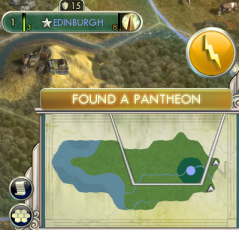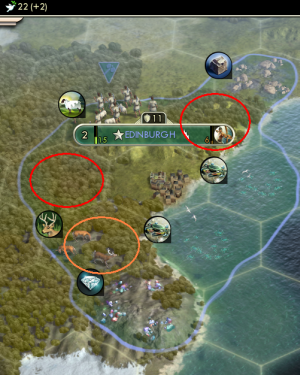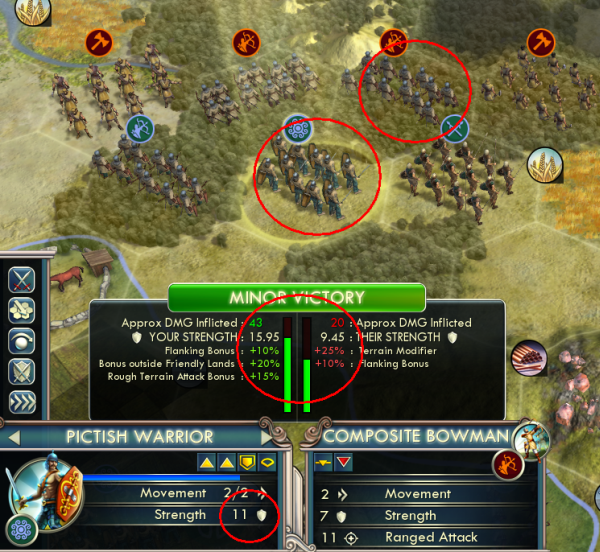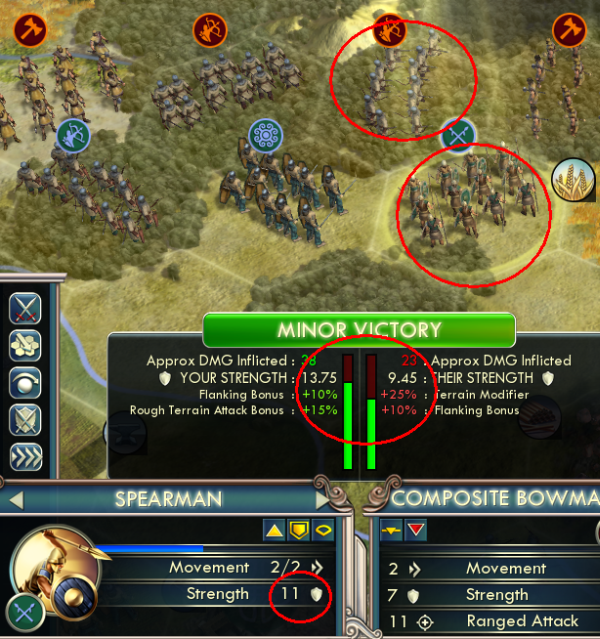The Celts

 Boudicca
Boudicca
"We Britons are used to women commanders in war;
I am the daughter of mighty men.
If the numbers of our warriors, if the causes of war weigh out,
whether we win or whether we fail will be decided in this field.
This is my plan; a woman's plan. Let the men live in slavery if they will!"
- Boudicca, as related by Tacitus


"We Britons are used to women commanders in war;
I am the daughter of mighty men.
If the numbers of our warriors, if the causes of war weigh out,
whether we win or whether we fail will be decided in this field.
This is my plan; a woman's plan. Let the men live in slavery if they will!"
- Boudicca, as related by Tacitus
The Celtic civilization, consisting of hundreds of tribes spread across much of western and central Europe during the late Iron Age, is represented in the game by the most celebrated warrior-queen of antiquity -- Queen Boudicca of the Iceni, a Celtic tribe in southern Great Britain at the time of the Roman invasions. "In stature she was very tall, in appearance most terrifying, in the glance of her eye most fierce...."
The warrior spirit of Queen Boudicca is well represented by the Celts’ unique unit, the Pictish Warrior. The Pictish Warrior and the Celts' unique ability to found an early religion position it well for early conquest and religious domination, setting the base for a powerful empire well into the late game.
Key Concepts
- Bee-line: The act of prioritizing a tech in the course of your research.
- Pillage-heal: The act of pillaging a tile in foreign territory and healing 25 hit points.
- Wide empire: An empire of numerous cities that are under-developed in comparison to a Tall empire.
- Tall empire: An empire of a small number of cities that tend to be well developed.

Founding a Pantheon
 per city with an adjacent unimproved forest or +2
per city with an adjacent unimproved forest or +2  per city with 3 or more adjacent unimproved forests. Druidic Lore allows the Celts to defer constructing shrines and temples while guaranteeing it a pantheon and providing a significant boost to founding a religion. As the game progresses, the faith benefit of Druidic Lore becomes much less significant, but on higher difficulty levels Druidic Lore may make the difference between being first or last to found a religion (or being able to found a religion at all).
per city with 3 or more adjacent unimproved forests. Druidic Lore allows the Celts to defer constructing shrines and temples while guaranteeing it a pantheon and providing a significant boost to founding a religion. As the game progresses, the faith benefit of Druidic Lore becomes much less significant, but on higher difficulty levels Druidic Lore may make the difference between being first or last to found a religion (or being able to found a religion at all).The Celts' forest start bias means you are highly likely to begin with at least one forest tile, and often 3 or more forest tiles, adjacent to your capital. If your initial settlement site does not have any adjacent forests (a start bias is not a start guarantee), you would be well-advised to explore for a better settlement site.
Assuming the Celtic capital has at least one adjacent forest tile, the Celts will ordinarily be the first to found a pantheon -- on turn 5 with three forests and on turn 10 with 1 or 2 forests. The Ethiopians will typically be second to found a pantheon--5-8 turns after they finish their monument replacement, the Stele. The only faster way to found a pantheon is to stumble across multiple religious city-states in the first few turns.
A few important notes:
- The unimproved forests must be immediately adjacent to your city center; it is not sufficient for the forest tiles to be within your city's culture borders.
- To obtain faith, the forest tiles must remain unimproved -- no camps, no lumber mills, no trading posts -- nothing but roads (which are not treated as an improvement for Druidic Lore purposes).
- It is not necessary that you assign any citizens to work the forest tiles; you earn faith based solely on those tiles' adjacency to your capital.

At some point it will be important to improve the deer/forest tile with a camp, which will leave Edinburgh with only 2 unimproved adjacent forest tiles, cutting its faith generation in half. Accordingly, to avoid stunting city development, the Celts must supplement Druidic Lore forest faith with more sustainable sources of faith, including shrines, temples and other sources.
Caution: As with everything, having an early advantage is very powerful. But the early advantage that Druidic Lore provides does not assure the Celts of being the first to found a religion. Even if the Celts quickly settle 4 or 5 cities, all amid forests, Druidic Lore may not provide enough faith quickly enough to enable the Celts to found an early religion or even found a religion at all (particularly on higher difficulty levels). As discussed in more detail below, the Celts still should take specific efforts to assure themselves of religious dominance, including taking some (or all) of the following actions:
- adopting a faith-giving pantheon belief
- building shrines and temples
- opening the Piety social policy tree (production doubled when building shrines and temples) and taking the Organized Religion social policy (+1
 from shrines and temples)
from shrines and temples)
- meeting and befriending religious city-states
- settling a city near a religious Natural Wonder
- building Stonehenge
- obtaining a Great Prophet by building The Hagia Sophia or from the Liberty or Piety finisher
- using its Unique Unit, the Pictish Warrior, to generate faith from kills
The Celts' Unique Unit is an Ancient Era Spearman replacement, the Pictish Warrior, which can be a meaningful source of faith and serve as the backbone of an early rush on a neighboring civilization. Its Unique Building is a Renaissance Era Opera House replacement, the Ceilidh Hall, providing both culture and happiness.

Cost: 56

Combat: 11

Movement: 2

Unique Promotions: Foreign Lands Bonus (+20% combat strength outside Celtic culture borders); No Movement Cost to Pillage
Unique Bonus: Earns 50% of opponent's strength as faith from kills
Requirements: Bronze Working (Tech)
Although the Pictish Warrior has the same cost and nominal combat strength as the Spearman it replaces, there are significant differences between the two. The Pictish Warrior receives a +20% combat bonus when fighting in lands outside Celtic culture borders, can pillage with no movement penalty, and gains faith from all enemy kills (equal to 50% of its vanquished foe's combat strength). On the other hand, the Pictish Warrior does not enjoy the Spearman's 50% combat bonus against mounted units.
The Pictish Warrior's faith-from-kills ability works in a manner similar to the culture-from-kills element of the Honor social policy opener (although the Honor opener only provides culture for barbarian kills, while the Pictish Warrior's unique ability applies to all kills). When the Pictish Warrior is upgraded to a Pikeman, it loses its ability to generate faith from kills, but retains its 20% foreign lands combat bonus and its ability to pillage without movement penalty, while also gaining the Pikeman's 50% combat bonus against mounted units.
The Pictish Warrior is a formidable early game melee unit. Its effective 13.2 combat strength (11 + 20%) in foreign lands is nearly the same as a swordsman (14 combat strength), at 75% of the cost and without the need for iron or Iron Working. The Pictish Warrior’s superior ability to survive an attack, pillage-heal, attack and kill an opponent 2 tiles away and generate faith on the kill, all in the same turn, makes it the cornerstone of any early Celtic military campaign.
The spoiler below illustrates the relative combat strength of a Pictish Warrior and a Spearman outside Celtic territory.
Spoiler Pictish Warrior and Spearman :
Since both the Pictish Warrior's combat bonus and pillage capability are not available in Celtic territory, you will want to confront invaders before they enter your territory. Preemptive invasions of your neighbors is the Celtic way; an early Pictish Warrior/Composite Bow rush is something to be feared. And since most of the Pictish Warrior's advantages are maintained after upgrading to Pikeman, a Medieval rush of upgraded Pikemen, Crossbows and Trebuchets can be formidable.

Cost: 200

Maintenance: 1

Special: 1
 , 3 Local City
, 3 Local City  and 1 Great Work of Music slot
and 1 Great Work of Music slotRequirements: Acoustics (Tech)
The Ceilidh Hall (roughly pronounced "kay-lee hall") is an Opera House replacement, available when you research Acoustics, which is a common entry tech to the Renaissance Era. Like other happiness buildings (circuses, colosseums, zoos, and stadiums), Ceilidh Halls provide Local City happiness, which is happiness limited to the population of the city.
The principal benefit of the Ceilidh Hall is that for a single 200
 investment and 1
investment and 1  maintenance, you obtain an Opera House (200
maintenance, you obtain an Opera House (200  and 1
and 1  maintenance for 1
maintenance for 1  and 1 Great Work of Music slot) that also provides more happiness than a Zoo (200
and 1 Great Work of Music slot) that also provides more happiness than a Zoo (200  and 2
and 2  maintenance for 2 Local City
maintenance for 2 Local City  ).
). Given how many buildings and units need to be built as you enter the Renaissance, a combined Opera House and free Zoo-and-a-half is a compelling value proposition. And, since you can still build a Zoo for additional happiness, a Ceilidh Hall+Zoo combination can provide a total of 5 Local City
 -- a significant source of mid- to late-game happiness.
-- a significant source of mid- to late-game happiness.Celt-Specific Strategies

Great Prophet
Religion should be the center-piece of any Celtic strategy. Their Unique Unit, the Pictish Warrior, provides an early boost to faith generation, but becomes obsolete before you leave the Medieval era. Their Unique Building provides mid- to late-game happiness, which is extremely helpful, but hardly game-making. That leaves the Celts' unique advantage in founding an early religion, and you should make every effort to capitalize on that advantage. Failing to do so is to squander the only enduring advantage the Celtic civilization offers.
What can a religion do for the Celts? A religion is potentially helpful to any civilization, but the Celts' ability to gain an early religion is a particular advantage, if the Celts can claim the most useful beliefs and spread their religion early and well.
- If pursuing any sort of Tall strategy (where happiness should not be an issue), the Celts should prioritize gold-giving founder beliefs (Church Property, Tithe or Initiation Rites) and the most effective passive spread enhancer belief that is available (Itinerant Preachers, Religious Texts or Papal Primacy). Preferred follower beliefs will depend mainly on your terrain, diplomatic situation and desired victory condition.
- If pursuing a Wide strategy, the Celts should prioritize happiness beliefs, such as Ceremonial Burial (1 Global happiness for every 2 cities following religion), and the most effective passive spread enhancer belief that is available (Itinerant Preachers, Religious Texts or Papal Primacy), and happiness providing follower beliefs, such as Asceticism (shrine happiness), Religious Center (temple happiness) or the religious buildings that provide happiness (Pagodas, Mosques, Cathedrals).
- If pursuing an early (pre-Industrial) domination strategy, with superior levels of faith generation, then Initiation Rites (to maximize early game gold), Holy Warriors (purchase pre-Industrial land units with faith), Asceticism (shrine happiness) and either Just War (20% combat bonus near foreign cities following religion) or a passive spread enhancer should be a solid combination.
- Alternatively, to speed you toward researching key military techs, Interfaith Dialogue (science from conversion missions), Holy Order (missionaries cost 30% less faith), Asceticism and Mosques would be a solid combination.
What are the best sources of faith for the Celts? Success with any religion-based strategy requires superior levels of faith generation. Druidic Lore will get you an early pantheon, but will not be enough to found an early religion (or perhaps any religion) or make the most of your religion -- for that you need lots and lots of faith.
As noted above, there are only so many sources of faith (or Great Prophets):
- Adopt a faith-giving pantheon belief. There are 10 faith-giving pantheon beliefs:
- Desert Folklore (faith from desert tiles)
- Dance of the Aurora (faith from forest-free tundra tiles)
- Earth Mother (faith from copper, iron and salt)
- God of War (faith from winning a battle within 4 tiles if your city)
- Goddess of Festivals (faith and culture from wine and incense)
- God-King (+1 faith, production, gold, culture and science in capital)
- One with Nature (faith from working Natural Wonders)
- Religious Idols (faith and culture from gold and silver)
- Stone Circles (faith from quarries)
- Tears of the Gods (faith from gems and pearls)
All of these can be helpful, but most are terrain dependent and should be adopted with an eye toward future city settlement sites, not just your capital. The problem is having to select a pantheon belief as early as turn 5 or 10, when your scouting efforts will have barely begun. But, whatever you choose, a faith-giving pantheon belief can be a great contributor for the entire game.
 Stonehenge
Stonehenge - Desert Folklore (faith from desert tiles)
- Build shrines and temples. Neither yields overwhelming amounts of faith, but faith does add up. The Celts generally should build both, although temples may come on later than for most civs. Both require investments of hammers or gold and incur ongoing maintenance costs (1 gold per unit of faith, unless you take the Piety policy Organized Religion, in which case the costs fall to 1 gold for 2 faith from shrines and 2 gold for 3 faith from temples). Sources of faith that do not have ongoing costs are greatly preferred.
- Meet and befriend religious city-states. This can be one of the most cost-effective ways of generating substantial amounts of faith for the entire game. Pictish Warriors are particularly well-suited to satisfying city-state barb quests, generating faith when they kill barbs, as well as CS influence.
- Settle a city near a religious Natural Wonder. At the cost of dedicating a citizen to working the Natural Wonder tile, you can generate as much (or more) faith than a shrine and a temple in that city.
- Build Stonehenge. Although the AI will tend to focus on building Stonehenge, it is obtainable on most difficulty levels if you beeline Calendar. If you have settled your capital next to 3 forests, it can be worth sacrificing 1 faith per turn to chop a forest to speed Stonehenge (save the other forest for a later wonder, and leave 1 forest to generate 1 faith per turn).
- Obtain a Great Prophet by building The Hagia Sophia or from the Piety finisher or Liberty finisher (or both). This can save you at least 300 faith per Great Prophet. To save an incremental 200+ faith (enough to buy an additional Missionary or religious building in the Medieval Era), try to time completion of the Hagia Sophia or the Liberty finisher for just after your second Great Prophet (the 300+ faith GP) naturally spawns; use the natural GP to spread your religion to 4 nearby cities and then enhance with the later GP. The Great Prophet from the Piety finisher does not increase the costs of future Great Prophets, so it can be taken at any time.
Success with the Celts does not require that you adopt any particular culture strategy. Celts can succeed Tall or Wide, opening with Tradition, Liberty or even Honor (where the opener synergizes well with the Pictish Warrior's faith-from-kills unique ability) or Piety. For Science and Diplomatic strategies, the left side of Rationalism and some combination of Patronage or Commerce, plus Order or Freedom as Ideology, are well-tested paths. Domination also benefits from a Rationalism focus, along with policies on the right side of Honor and either Order or Autocracy. For culture games, prioritizing Piety and Aesthetics are still the most reliable paths. However, none of these culture paths are unique to the Celts.
The Celts should be well-positioned to pursue a a Wide, mixed Liberty/Piety strategy, although the lack of culture in the Piety social policy tree means this strategy is best executed if you pop an early culture ruin (or two) and/or are able to take a strong culture-giving pantheon, such as Goddess of Festivals (faith and culture from wine and incense), Religious Idols (faith and culture from gold and silver), God of the Open Sky (culture from pastures), Oral Traditions (culture from plantations) or Sacred Path (culture from jungle). In this strategy, you would take the left side of the Liberty social policy tree (to Collective Rule and the free settler) and then open Piety, taking Organized Religion (+1 faith from shrines and temples) and proceeding directly to Reformation, all while producing settlers without interruption, until available city sites have been settled, prioritizing monuments, shrines and temples in each city.
For such a strategy, the most useful Reformation beliefs would be Charitable Missions (+30% more influence from gold gifts to city-states, to assist in befriending and allying mercantile city-states for additional happiness), Jesuit Education (allowing you to faith-buy universities, public schools and research labs) and To the Glory of God (allowing you to use faith to purchase any type of Great Person starting in the Industrial era). You could also pursue a Sacred Sites (buildings purchased with faith provide 2 tourism) culture victory strategy, although that is a difficult strategy to execute on higher difficulty levels.
Conclusion
The Celts are a versatile and thoroughly enjoyable civ to play -- whether you like to pursue Tall or Wide strategies, or play peaceful or aggressive games. Explore the religious advantages the Celts present, and find your path to victory.


